Everyone wants their sleeping bags to last for many years to come. But, if you don’t know how to care for and clean your bag properly, then it can be a bit of an issue. To take care of your bag you need to keep it clean and follow some few easy steps.
It is important to know how to wash down sleeping bag using different methods and tools. Using these, easy cleaning tips, you can take care of your bag and make sure that it stays with you for a long time.

A Few Important Tips Before Washing Your Bag
No matter what type your bag is, keeping it dry and clean during camping, will keep it in good condition.

It will insulate more efficiently and remain durable. For synthetic bags, you can follow a few more other tips. For example:
- Clean clothes: Wearing clean clothes when you are going to sleep, is recommended to keep your sleeping bag clean. We know that after a day of hiking you are exhausted and changing clothes isn’t what you really want to do. But, you can try to wear clean socks and underwear, and clean your face and keep the dirt off by using a sunscreen that you will wash off before sleep. If the weather is warm, then you can change into a clean shirt and underwear. If you get into the sleeping bag with all the dirt on you, it will affect the insulation of your sleeping bag.
- Sleeping bag liner: Another good option to keep your bag clean is to use a liner. They are made of cotton, polyester, silk or wool, and are light in weight. They act as a separating screen between your skin and the sleeping bag, and keep the dirt off of your bag. Additionally, they add 5 to 10 degrees Fahrenheit to the bags temperature rating. You can wash the liner at the end of your trip and you can take it to another trip.
- Ground protection: In case that you have to sleep on the ground, you need to put a pad under your sleeping bag to protect it from the ground. Even if the bag is waterproof it will need protection against sharp sticks and conifer terrains. Read our article on how to make your own tent footprints to find out more.
- Treat it with care: Treat your bag gently and don’t jump around while you are in it. If you want to wrap around the bag while sitting near the fire, you should bring an older synthetic bag. Nobody wants to see holes due to sparks, on their brand new bag.
- Use zippers gently: Zippers can be a bit tricky sometimes, so, if you want to zip up your bag easily, practice it at home. Use the zipper gently so that you don’t yank it or snag it. If the zipper is two ways, then it may be frustrating for you, be patient so that you don’t cause a fabric tear. Here’s what to do if your zipper needs repairing, check out our previous post on this.
- Airing out the bag: Never leave your bag in the sunlight for very long because the UV rays can be harmful to the fabric. If the bag is wet, then wait for the moisture to air out. When you get home from a camping trip, airing out the bag is recommended. And, if someone wants to borrow your sleeping bag, then make sure that they understand how its zippers work and ask them to use it with care.
Things you also need to know
Before we explain how to wash your sleeping bag, you need to know things that you should not do:
- Don’t use fabric softener any kind of bleach or its alternative products on your sleeping bag
- Don’t dry clean your sleeping bag. Dry cleaning solvents are used that can remove the natural oils that are necessary for down bags to retain its loft.
- Don’t wash your sleeping bag in the machine with an agitator as it can damage the seam
Taking care of your sleeping bag
In order to keep your bag in shape you need to check it once in a while to make sure that seams, zippers and cords are working.
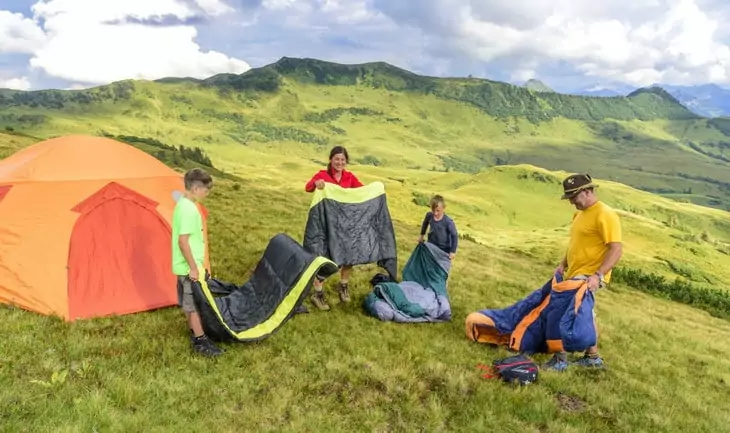
Check the insulation to see if it’s equally spread. Washing and drying can alleviate it sometimes.
DWR Restoration
As the bag gets older its original DWR (durable water repellent) finish wears off. There are a lot of products available that can help you with the restoring of DWR.
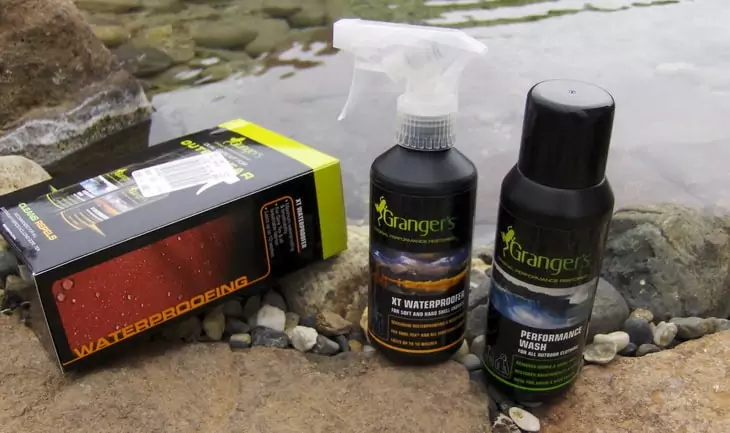
This restoration of water repellent finish will also help to keep the bag cleaner.
Broken zippers and tears
In case that there is a small hole or a fabric tear on your sleeping bag when you’re out camping, here are a few options for you to deal with it:
- Use the needle and thread in your repair kit and sew the hole with your hands. After you get home, you can unstitch it and get it done with a sewing machine properly.
- The other option is to cut a patch from your gear repair kit and put it over the hole using a glue. The downside of this is that if you try to peel it off later it can tear the fabric because of the stickiness.
- A bandage can also be used to cover the hole from the first aid kit.
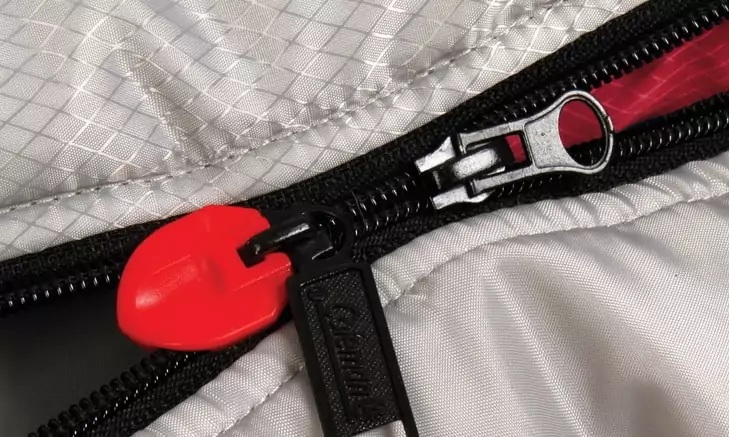
If the hole or the tear is bigger, you might consider getting it repaired by a professional.
Types of insulation
The washing of a sleeping bag depends a lot on either its synthetic or down so you need to know about the types.
Synthetic Insulation
Synthetic dozing sacks are far warmer than down synthetic packs when wet in view of the synthetic bag’s capacity to maintain the loft.
They dry rather rapidly as well, that is the reason a great many people incline toward them regardless of the possibility that they cost somewhat more. Synthetic materials will keep you warm, notwithstanding, when wet, so on the off chance that you are heading off to a timberland or a stormy place, then synthetic bag may be a superior choice for you.
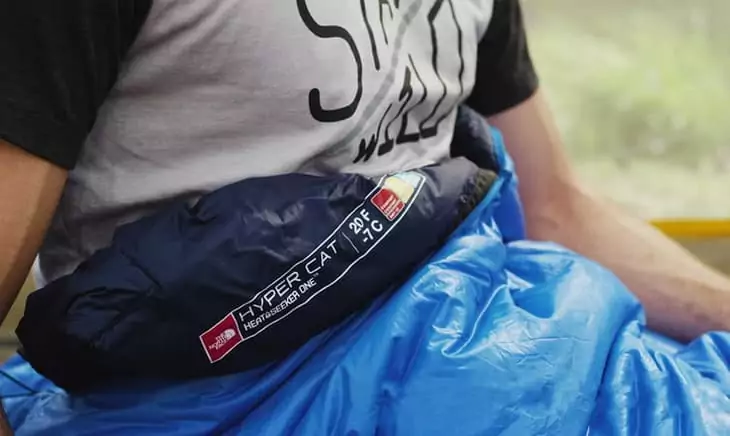
Despite the fact that the odds of your sleeping pack getting wet are low on the grounds that on the off chance that you are conveying a waterproof rucksack then it unravels your issue. It’s actually that synthetic sacks perform well when they are wet, however, no wet pack can be agreeable to rest in. In the event that you rest in a wet pack you are most likely not going to get a decent night’s rest comfortable.
Down insulation
Down sleeping bags are light weight and give more warmth, they are more compressed and keeps going just about 2-4 times longer than synthetic sleeping packs. The drawback of down protected packs is that they cost progressively and when wet, they lose hang, which implies that if the resting sack is wet then it won’t keep you warm. Additionally down sleeping packs will set aside a more drawn out opportunity to dry.

There are top notch packs accessible that offer more protection for certain weight that implies, if the weight is short of what it can give better warmth and accomplish a similar space. Something else that you have to consider is that on the off chance that you need to take a warm resting sack with you then it will likewise add weight to your backpack. The warmer sleeping bag implies that you’ll be conveying the additional weight and likely be excessively hot in the evenings as well.
Storing and stuffing of the sleeping bag
When you are on the move you carry your sleeping bag in your bag pack in a storage pack. If you keep it compactly in the storage pack and try to follow some simple tips it will help with keeping it clean. Here are some tips on using the storage bag:
When you put the sleeping bag in the storage pack start inserting the foot first with the zipper partially closed and then firmly do the rest of it, this will discharge the air from the top of bag and that will in turn put even pressure on the stitching.
In case your sleeping bag has a waterproof shell you should turn the bag inside out before putting it in the storage pack. This is recommended because the outer shell can trap the air by acting as a balloon and that can be a frustrating experience for you.
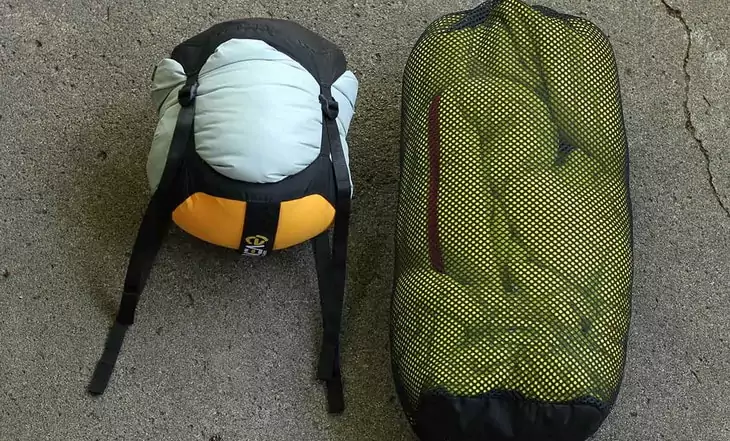
Your storage bag should be larger so that you can easily put your sleeping bag in it and it can be compressed more in your backpack to save space. Compression storage bags help to save the space in the backpack. Built in straps are also used to compress it more. But you need to be careful because keeping the bag compressed for longer duration can damage the loft. Waterproof storage bags are a great option in case there are chances of rain. It will protect the bag if you are not carrying it in your backpack.
Another option is to wrap your backpack with a plastic sheet so that it remains dry because wet down bag doesn’t work efficiently and won’t keep you warm. Although synthetic bag works fine even when wet. If you want your bag to have a longer life span, then you need to store it with proper care. After a trip you should get you sleeping out and let it air out and ensure that it’s completely dry.
Cleaning a sleeping bag
Your cleaning of the sleeping bag will depend on whether it’s synthetic or down. Down bags usually are more difficult to clean because they demand more attention and time. Therefore, most of the campers take it to the professionals for the cleaning, but using these tips you can do it yourself.
Spot Cleaning
Spot cleaning is your first option of cleaning your bag without causing any damage. If your bag is not very old then in most cases it just needs spot cleaning, not a full cleaning.
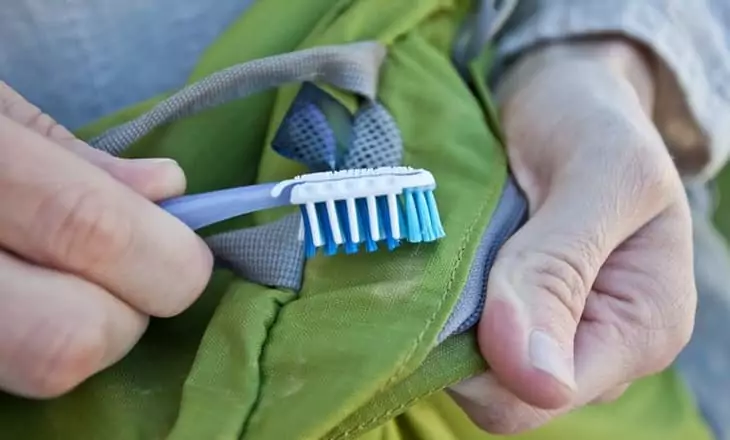
For spot cleaning, you need to make a paste of non-detergent soap and water and with the help of a toothbrush, you can carefully clean the shell. Pay more attention to the hood and collar of the sleeping bag where skin and hair oils get stuck often. To wash the bag without getting inside wet you can hold the shell or liner away from the insulation. Avoid the full cleaning as long as you can because it can be the cause of wear and tear.
Washing the sleeping bag
In case that your sleeping bag is darkened with dirt and losing loft then you have to give it a full cleaning. The first thing you need to do is to read the manufacturer’s instructions and the precautions. They are usually written on a tag that is attached to the bag somewhere. You must follow those instructions.

A lot of people choose to get their bag laundered by a professional. But if you want to clean it yourself, then you should know that the drying alone will take hours. Also, you need to make sure that the soap you are using is a non-detergent and is made to wash synthetic or down filled things.
How to wash a sleeping bag by using hands
To wash down a sleeping bag with hands can be a little tiring but if you do it right then it lessens the chances of wear and tear.
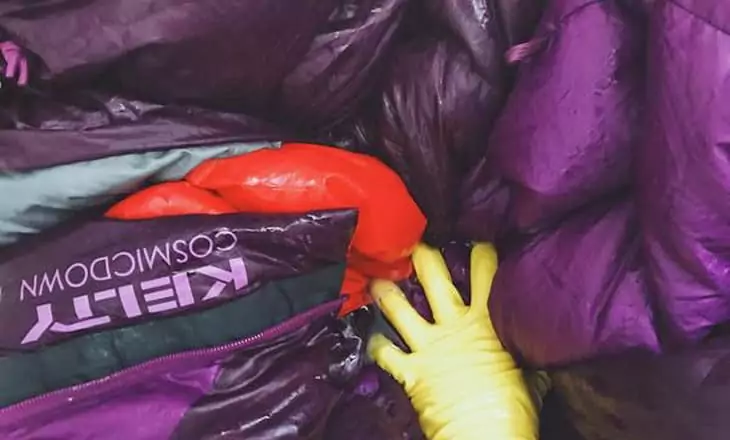
Here is what you need to do to wash the bag using hands:
- Step 1: First, add the appropriate soap for a synthetic or down bag in a tub filled with warm or cold water. And try not to put too much soap in the tub because it will make it harder to rinse it out later.
- Step 2: Now put the bag in the tub and gently rub the soap throughout the bag. Work a little more on the areas that are heavily soiled. Let the bag soak in the water for 1 or 2 hours.
- Step 3: Let the water drain and press out all the remaining water from the sleeping bag.
- Step 4: To rinse the sleeping bag you need to fill the tub again with warm or cold water and then try to get out as much soap as you can from the bag. Allow the bag to soak for 15 minutes and then drain the water. Rinse it until you get all the soap out of it.
- Step 5: Get as much water out as you can and then with the help of your hands gather it in your arms and carry it in the dryer for drying. This will help you prevent any ripping and straining the seams.
- Step 6: If you have a big enough dryer that can fit a sleeping bag then use it. Otherwise, you have to take it to a Laundromat.
- Step 7: In case that you don’t want to carry the wet bag to a Laundromat the, you can lay the bag on a clean surface in sunlight to let it dry. In this scenario, you will need to break down clumps of insulation by yourself.
How to wash down a sleeping bag with a washing machine
Almost all the sleeping bags can be machine washed. They are usually cleaned up in front loader of the washing machine.

In some cases, the front loader of the machine isn’t big enough to clean and tumble your sleeping bag thoroughly so keep that in mind.
- Step 1: In this case, put warm or cold water in the machine and add the soap.
- Step 2: Try not to add too much soap to avoid over-sudsing.
- Step 3: To keep the balance of the spin of the machine you can try adding other damp articles such as T-shirts and towels.
- Step 4: After its cleaned make sure you get all the soap out.
- Step 5: Rinse it twice with clean water and run it through a soap free wash and rinse process.
Drying the bag
Put the dryer setting on low heat and keep checking it time to time because if it’s too hot it can damage the fabric and its synthetic fill so you need to be careful.
In the case of a down bag when it is almost dry, try adding two or more tennis balls in the dryer or a pair of sneakers. This will help with the restoration of the loft by breaking any clumps of down while it spins.
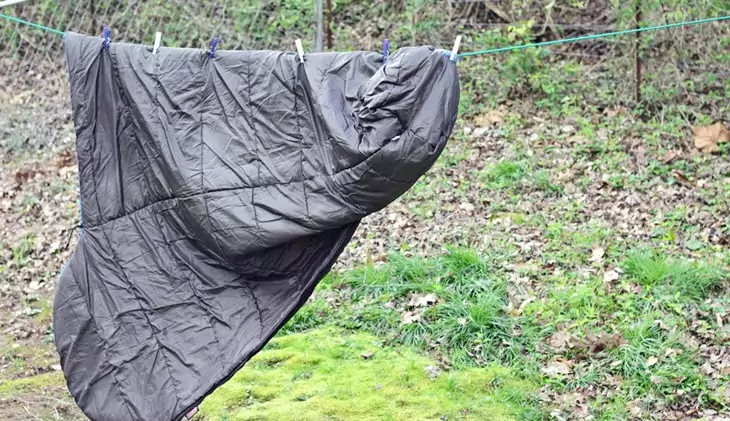
And in the end, make sure it’s completely dry before you put it in the storage bag. To be sure you can leave it out for a night or try hanging it up by toe loops.
For tips on how to properly clean all kinds of sleeping bags, see our amazing piece dealing on this topic.
What Have We Learned?
You should now be able to wash down your bag without any problems. You need to carefully read each and every piece of information mentioned in the article, the washing method depends on the type of your sleeping bag. Down filled sleeping bags are a bit difficult to wash down on your own, but it can be done without causing any damage if you do it right.
To find out the best down sleeping bags to keep you warm and toasty, see our article on this topic.

Additionally, taking care of your bag is necessary to keep it clean and to make sure that it lasts longer. If you think that we have missed some important washing tip then please share it with us in the comments.








If washing your down sleeping bag is an issue for you, you can always use a sleeping bag liner to prevent dirt, fine sand and other elements from dirtying the down insulation.
Washing your down sleeping bag using a washing machine is unwise. If washing is an issue, you can choose to use a sleeping bag liner to avoid dirtying your bag.